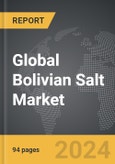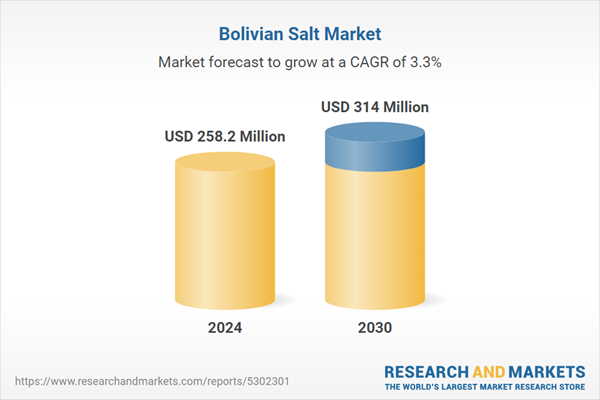The global market for Bolivian Salt was valued at US$258.2 Million in 2024 and is projected to reach US$314.0 Million by 2030, growing at a CAGR of 3.3% from 2024 to 2030. This comprehensive report provides an in-depth analysis of market trends, drivers, and forecasts, helping you make informed business decisions. The report includes the most recent global tariff developments and how they impact the Bolivian Salt market.
Segments: Application (Bath Care, Aromatherapy, Therapeutic, Home Care, Fertilizers, Other Applications).
Geographic Regions/Countries: World; United States; Canada; Japan; China; Europe (France; Germany; Italy; United Kingdom; Spain; Russia; and Rest of Europe); Asia-Pacific (Australia; India; South Korea; and Rest of Asia-Pacific); Latin America (Argentina; Brazil; Mexico; and Rest of Latin America); Middle East (Iran; Israel; Saudi Arabia; United Arab Emirates; and Rest of Middle East); and Africa.
The analysts continuously track trade developments worldwide, drawing insights from leading global economists and over 200 industry and policy institutions, including think tanks, trade organizations, and national economic advisory bodies. This intelligence is integrated into forecasting models to provide timely, data-driven analysis of emerging risks and opportunities.
Global Bolivian Salt Market - Key Trends and Drivers Summarized
What Is Bolivian Salt and How Is It Harvested?
Bolivian salt, often referred to as pink salt, is harvested from the vast salt flats of Salar de Uyuni, the world's largest salt flat, located in the high-altitude plateau of Bolivia. The salt is a result of ancient lakes that evaporated over thousands of years, leaving behind thick layers of mineral-rich salt deposits. The harvesting process is both traditional and sustainable, with workers extracting the salt by hand using simple tools, ensuring that the natural landscape is preserved. Bolivian salt is known for its purity and unique mineral composition, including trace elements such as calcium, magnesium, and potassium, which give it a distinctive flavor and color. While it shares similarities with Himalayan pink salt, Bolivian salt stands out due to its high-altitude origin and the minimal processing it undergoes. This natural method of extraction, combined with its rich mineral content, makes it a sought-after product in gourmet cooking and wellness circles.Why Is Bolivian Salt Important for the Culinary and Wellness Industries?
Bolivian salt has gained significant attention in the culinary and wellness industries due to its unique taste profile and perceived health benefits. Chefs around the world are increasingly using Bolivian salt in gourmet dishes because of its subtle, balanced flavor that enhances food without overpowering it. Its natural mineral content provides a more complex taste than standard table salt, making it a favored choice for seasoning meats, vegetables, and even in artisanal food products like chocolates and cheeses. In the wellness industry, Bolivian salt is often marketed as a healthier alternative to regular salt due to its natural mineral content. Some proponents claim that the trace minerals in Bolivian salt can help balance electrolytes, improve hydration, and support overall health, although these benefits are more anecdotal than scientifically proven. Furthermore, Bolivian salt is used in beauty and spa products, where it is incorporated into bath salts and scrubs, with its exfoliating and detoxifying properties being highly valued by those seeking natural skincare solutions. The growing consumer preference for natural, minimally processed products has also played a key role in increasing the demand for Bolivian salt, positioning it as a premium alternative in both culinary and wellness markets.How Is Bolivian Salt Adapting to Modern Consumer Trends and Environmental Concerns?
As consumer preferences shift towards more sustainable and ethically sourced products, Bolivian salt is increasingly aligning with these trends. The extraction of Bolivian salt is done through low-impact, traditional methods that preserve the natural ecosystem of Salar de Uyuni. This focus on sustainability resonates with modern consumers who are looking for products that have minimal environmental footprints. Furthermore, Bolivian salt producers often emphasize fair trade practices, ensuring that local communities benefit from the production and sale of the salt. This ethical approach to sourcing and production is becoming more important to consumers, particularly in the wellness and organic food markets. In addition to its sustainability credentials, Bolivian salt is responding to the rise of clean-label and organic food movements. With consumers demanding greater transparency about where their food comes from and how it’s processed, Bolivian salt’s all-natural, unrefined status fits perfectly into these trends. Unlike highly processed table salts that contain additives and anti-caking agents, Bolivian salt is free from artificial chemicals, appealing to health-conscious individuals who are wary of synthetic ingredients in their diets. Moreover, the packaging of Bolivian salt is adapting to consumer demands for environmentally friendly products, with more companies using biodegradable or recyclable materials to reduce waste. These shifts ensure that Bolivian salt remains relevant and appealing to consumers who are increasingly prioritizing sustainability and health in their purchasing decisions.What Are the Key Growth Drivers of the Bolivian Salt Market?
The growth of the Bolivian salt market is driven by several factors, including increasing demand for gourmet and specialty salts, rising consumer awareness of natural products, and the global expansion of the wellness industry. One of the key drivers is the growing interest in gourmet cooking and artisanal foods, where unique salts like Bolivian salt are prized for their distinct flavor and mineral content. As more consumers seek to enhance their culinary experiences at home, the demand for high-quality, natural ingredients has surged, positioning Bolivian salt as a premium option for both amateur cooks and professional chefs. Additionally, the global wellness movement, which emphasizes the use of natural, minimally processed ingredients for health and well-being, has also fueled the demand for Bolivian salt. Consumers are increasingly looking for alternatives to processed table salts, drawn to the perceived health benefits of trace minerals found in natural salts. Another factor driving market growth is the increasing emphasis on ethical and sustainable sourcing. Bolivian salt producers are capitalizing on the growing consumer preference for sustainably harvested and fair-trade products, offering a transparent supply chain that supports local Bolivian communities while preserving the unique environment of Salar de Uyuni. As more consumers prioritize sustainability in their purchasing decisions, Bolivian salt’s environmentally friendly harvesting process is a significant selling point. Furthermore, the rise of e-commerce and global distribution networks has made Bolivian salt more accessible to international markets. Online platforms and specialty retailers have expanded the reach of this niche product beyond South America, allowing it to gain traction in North America, Europe, and Asia. Finally, the increasing use of Bolivian salt in health and beauty products, such as bath salts and scrubs, has expanded its market beyond the culinary space.Report Scope
The report analyzes the Bolivian Salt market, presented in terms of units. The analysis covers the key segments and geographic regions outlined below.Segments: Application (Bath Care, Aromatherapy, Therapeutic, Home Care, Fertilizers, Other Applications).
Geographic Regions/Countries: World; United States; Canada; Japan; China; Europe (France; Germany; Italy; United Kingdom; Spain; Russia; and Rest of Europe); Asia-Pacific (Australia; India; South Korea; and Rest of Asia-Pacific); Latin America (Argentina; Brazil; Mexico; and Rest of Latin America); Middle East (Iran; Israel; Saudi Arabia; United Arab Emirates; and Rest of Middle East); and Africa.
Key Insights:
- Market Growth: Understand the significant growth trajectory of the Bath Care segment, which is expected to reach US$106.5 Million by 2030 with a CAGR of a 2.6%. The Aromatherapy segment is also set to grow at 3.8% CAGR over the analysis period.
- Regional Analysis: Gain insights into the U.S. market, valued at $69.4 Million in 2024, and China, forecasted to grow at an impressive 4.6% CAGR to reach $60.2 Million by 2030. Discover growth trends in other key regions, including Japan, Canada, Germany, and the Asia-Pacific.
Why You Should Buy This Report:
- Detailed Market Analysis: Access a thorough analysis of the Global Bolivian Salt Market, covering all major geographic regions and market segments.
- Competitive Insights: Get an overview of the competitive landscape, including the market presence of major players across different geographies.
- Future Trends and Drivers: Understand the key trends and drivers shaping the future of the Global Bolivian Salt Market.
- Actionable Insights: Benefit from actionable insights that can help you identify new revenue opportunities and make strategic business decisions.
Key Questions Answered:
- How is the Global Bolivian Salt Market expected to evolve by 2030?
- What are the main drivers and restraints affecting the market?
- Which market segments will grow the most over the forecast period?
- How will market shares for different regions and segments change by 2030?
- Who are the leading players in the market, and what are their prospects?
Report Features:
- Comprehensive Market Data: Independent analysis of annual sales and market forecasts in US$ Million from 2024 to 2030.
- In-Depth Regional Analysis: Detailed insights into key markets, including the U.S., China, Japan, Canada, Europe, Asia-Pacific, Latin America, Middle East, and Africa.
- Company Profiles: Coverage of players such as Bathclin Corporation, Borghese Inc., Dadakarides Salt SA, Kneipp GmbH, L'Occitane International SA and more.
- Complimentary Updates: Receive free report updates for one year to keep you informed of the latest market developments.
Some of the 43 companies featured in this Bolivian Salt market report include:
- Bathclin Corporation
- Borghese Inc.
- Dadakarides Salt SA
- Kneipp GmbH
- L'Occitane International SA
- Nesalla Bath Salt
- Parfums de Coeur, Ltd.
- San Francisco Salt Company
- Shanghai Jahwa United Co. Ltd.
- Shiseido Company Limited
- Stenders SIA
Tariff Impact Analysis: Key Insights for 2025
Global tariff negotiations across 180+ countries are reshaping supply chains, costs, and competitiveness. This report reflects the latest developments as of April 2025 and incorporates forward-looking insights into the market outlook.The analysts continuously track trade developments worldwide, drawing insights from leading global economists and over 200 industry and policy institutions, including think tanks, trade organizations, and national economic advisory bodies. This intelligence is integrated into forecasting models to provide timely, data-driven analysis of emerging risks and opportunities.
What’s Included in This Edition:
- Tariff-adjusted market forecasts by region and segment
- Analysis of cost and supply chain implications by sourcing and trade exposure
- Strategic insights into geographic shifts
Buyers receive a free July 2025 update with:
- Finalized tariff impacts and new trade agreement effects
- Updated projections reflecting global sourcing and cost shifts
- Expanded country-specific coverage across the industry
Table of Contents
I. METHODOLOGYII. EXECUTIVE SUMMARY2. FOCUS ON SELECT PLAYERSIII. MARKET ANALYSISSOUTH KOREAREST OF ASIA-PACIFICARGENTINABRAZILMEXICOREST OF LATIN AMERICAIRANISRAELSAUDI ARABIAUNITED ARAB EMIRATESREST OF MIDDLE EASTIV. COMPETITION
1. MARKET OVERVIEW
3. MARKET TRENDS & DRIVERS
4. GLOBAL MARKET PERSPECTIVE
UNITED STATES
CANADA
JAPAN
CHINA
EUROPE
FRANCE
GERMANY
ITALY
UNITED KINGDOM
SPAIN
RUSSIA
REST OF EUROPE
ASIA-PACIFIC
AUSTRALIA
INDIA
LATIN AMERICA
MIDDLE EAST
AFRICA
Companies Mentioned (Partial List)
A selection of companies mentioned in this report includes, but is not limited to:
- Bathclin Corporation
- Borghese Inc.
- Dadakarides Salt SA
- Kneipp GmbH
- L'Occitane International SA
- Nesalla Bath Salt
- Parfums de Coeur, Ltd.
- San Francisco Salt Company
- Shanghai Jahwa United Co. Ltd.
- Shiseido Company Limited
- Stenders SIA
Table Information
| Report Attribute | Details |
|---|---|
| No. of Pages | 94 |
| Published | April 2025 |
| Forecast Period | 2024 - 2030 |
| Estimated Market Value ( USD | $ 258.2 Million |
| Forecasted Market Value ( USD | $ 314 Million |
| Compound Annual Growth Rate | 3.3% |
| Regions Covered | Bolivia, Global |









